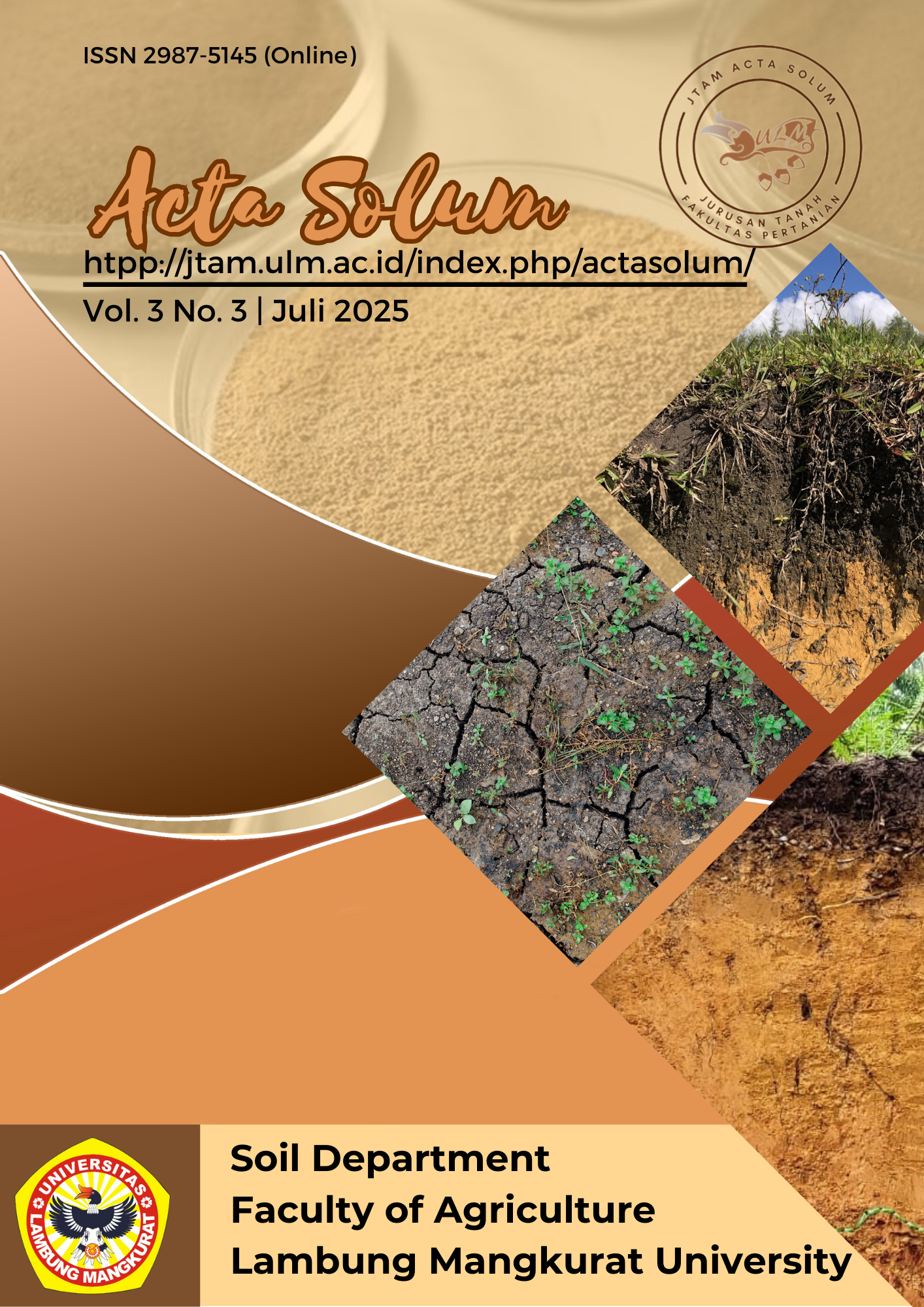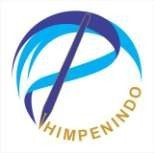Unveiling the BPF9 Isolate as a Potential of Phosphate-Solubilizing Bacteria Through In Vitro Characterization
Abstract
The increasing demand for food has driven agricultural intensification, particularly through the use of phosphate fertilizers. However, phosphorus uptake efficiency by plants remains low due to its predominance in insoluble forms in the soil. One promising alternative is the use of phosphate-solubilizing bacteria (PSB). This study aimed to evaluate the solubilization potential of the BPF9 isolate through qualitative and quantitative assays, as well as growth curve profiling. The research was conducted at the Soil and Environmental Biotechnology Laboratory, IPB University. Qualitative phosphate solubilization was assessed on Pikovskaya agar by measuring halo zone formation to calculate the solubilization index (SI). Quantitative analysis was carried out using spectrophotometry at 660 nm. The bacterial growth curve was analyzed using the haemocytometer method. Results showed that BPF9 had a solubilization index of 2.0 (moderate category) and was able to solubilize phosphate up to 128.5 ppm, which is considered highly efficient. The growth curve indicated that BPF9 entered the exponential phase at 26 hours and reached its maximum population at 42 hours. These findings indicate that BPF9 possesses strong phosphate-solubilizing capability and stable growth characteristics, making it a promising candidate for biofertilizer development.
References
Aliyat, F. Z., Maldani, M., Guilli, M. El, Nassiri, L., & Ibijbijen, J. 2020. Isolation and Characterization of Phosphate Solubilizing Bacteria from Phosphate Solid Sludge of the Moroccan Phosphate Mines. The Open Agriculture Journal, 14, 16–24. http://dx.doi.org/10.2174/1874331502014010016
Al-zboon, H. S., & Alharayzeh, M. I. Y. 2023. The Impact of Guessing on the Accuracy of Estimating Simple Linear Regression Equation Parameters and the Ability to Predict. International Journal of Instruction, 16(2), 927–944. https://doi.org/10.29333/iji.2023.16249a
Beheshti, M., Alikhani, H. A., Pourbabaee, A. A., Etesami, H., Asadi Rahmani, H., & Noroozi, M. 2022. Enriching periphyton with phosphate-solubilizing microorganisms improves the growth and concentration of phosphorus and micronutrients of rice plant in calcareous paddy soil. Rhizosphere, 24, 100590. https://doi.org/10.1016/j.rhisph.2022.100590
Elfiati, D., DELVIAN, D., Hanum, H., Susilowati, A., & Rachmat, H. H. 2021. Potential of phosphate solubilizing fungi isolated from peat soils as inoculant biofertilizer. Biodiversitas Journal of Biological Diversity, 22(6). https://doi.org/10.13057/biodiv/d220605
He, D., & Wan, W. 2022. Distribution of Culturable Phosphate-Solubilizing Bacteria in Soil Aggregates and Their Potential for Phosphorus Acquisition. Microbiology Spectrum, 10(3). https://doi.org/10.1128/spectrum.00290-22
Hong, S., Gan, P., & Chen, A. 2019. Environmental controls on soil pH in planted forest and its response to nitrogen deposition. Environmental Research, 172, 159–165. https://doi.org/10.1016/j.envres.2019.02.020
Jufri, R. F. 2020. The Effect of Environmental Factors on Microbial Growth. Journal La Lifesci, 1(1), 12–17. https://doi.org/10.37899/journallalifesci.v1i1.32
Kaur, T., Devi, R., Kumar, S., Sheikh, I., Kour, D., & Yadav, A. N. 2022. Microbial consortium with nitrogen fixing and mineral solubilizing attributes for growth of barley (Hordeum vulgare L.). Heliyon, 8(4), e09326. https://doi.org/10.1016/j.heliyon.2022.e09326
Kumakura, D., Yamaguchi, R., Hara, A., & Nakaoka, S. 2023. Disentangling the growth curve of microbial culture. Journal of Theoretical Biology, 573, 111597. https://doi.org/10.1016/j.jtbi.2023.111597
Lynn, T. M., Win, H. S., Kyaw, E. P., Latt, Z. K., & Yu, S. S. 2013. Characterization of Phosphate Solubilizing and Potassium Decomposing Strains and Study on their Effects on Tomato Cultivation. International Journal of Innovation and Applied Studies, 3(4), 959–966. Retrieved from https://ijias.issr-journals.org/abstract.php?article=IJIAS-13-147-12
Mengesha, A. S., & Legesse, N. H. 2024. Isolation and characterization of phosphate solubilizing bacteria from the rhizosphere of lentil (Lens culinaris M.) collected from Hagere Mariam district, Central Ethiopia. PLOS ONE, 19(11), e0308915. https://doi.org/10.1371/journal.pone.0308915
Naomi, M. R., Supriyono, Nurmalasari, I. A., & Pardono. 2021. Role of phosphate fertilizer on growth and yield of hybrid maize (Zea mays L.). IOP Conference Series: Earth and Environmental Science, 637(1), 012070. https://doi.org/10.1088/1755-1315/637/1/012070
Oedjijono, Widodo, P., Wiraswati, S. M., Alfisah, R. K., Mariana, A., & Pratiwi, M. 2024. Isolation And Screening Of Bacteria With Plant Growth Promotion Traits From Iron Sand Soils of Central Jawa South Coast. Proceeding ICMA-SURE-2024, 451–457. Retrieved from https://www.researchgate.net/publication/392621553_Proceeding_ICMA-SURE-2024_The_7_th_International_Conference_on_Multidisciplinary_Approaches_for_Sustainable_Rural_Development_ISOLATION_AND_SCREENING_OF_BACTERIA_WITH_PLANT_GROWTH_PROMOTION_TRAITS_FRO
Pan, L., & Cai, B. 2023. Phosphate-Solubilizing Bacteria: Advances in Their Physiology, Molecular Mechanisms and Microbial Community Effects. Microorganisms, 11(12), 2904. https://doi.org/10.3390/microorganisms11122904
Pande, A., Pandey, P., Mehra, S., Singh, M., & Kaushik, S. 2017. Phenotypic and genotypic characterization of phosphate solubilizing bacteria and their efficiency on the growth of maize. Journal of Genetic Engineering and Biotechnology, 15(2), 379–391. https://doi.org/10.1016/j.jgeb.2017.06.005
Paul, D., & Sinha, S. N. 2017. Isolation and characterization of phosphate solubilizing bacterium Pseudomonas aeruginosa KUPSB12 with antibacterial potential from river Ganga, India. Annals of Agrarian Science, 15(1), 130–136. https://doi.org/10.1016/j.aasci.2016.10.001
Rech, I., Withers, P. J. A., Jones, D. L., & Pavinato, P. S. 2018. Solubility, Diffusion and Crop Uptake of Phosphorus in Three Different Struvites. Sustainability, 11(1), 134. https://doi.org/10.3390/su11010134
Sharma, S. B., Sayyed, R. Z., Trivedi, M. H., & Gobi, T. A. 2013. Phosphate solubilizing microbes: sustainable approach for managing phosphorus deficiency in agricultural soils. SpringerPlus, 2(1), 587. https://doi.org/10.1186/2193-1801-2-587
Situmorang, E. C., Prameswara, A., Sinthya, H. C., Toruan-Mathius, N., & Liwang, T. 2015. Indigenous Phosphate Solubilizing Bacteria from Peat Soil for an Eco-friendly Biofertilizer in Oil Palm Plantation. KnE Energy, 1(1), 65. https://doi.org/10.18502/ken.v1i1.324
Subaedah, St., Ralle, A., & Sabahannur, St. 2018. Phosphate Fertilization Efficiency Improvement with the Use of Organic Fertilizer and its Effect on Soybean Plants in Dry Land. Pakistan Journal of Biological Sciences, 22(1), 28–33. https://doi.org/10.3923/pjbs.2019.28.33
Ughy, B., Nagyapati, S., Lajko, D. B., Letoha, T., Prohaszka, A., Deeb, D., Der, A., Pettko-Szandtner, A., & Szilak, L. 2023. Reconsidering Dogmas about the Growth of Bacterial Populations. Cells, 12(10), 1430. https://doi.org/10.3390/cells12101430
Wang, C., Pan, G., Lu, X., & Qi, W. 2023. Phosphorus solubilizing microorganisms: potential promoters of agricultural and environmental engineering. Frontiers in Bioengineering and Biotechnology, 11. https://doi.org/10.3389/fbioe.2023.1181078
Wijaya, R. C., Utari, E. L., & Yudianingsih, Y. 2015. Perancangan Alat Penghitung Bakteri. Respati, 10(29). https://doi.org/10.35842/jtir.v10i29.138
Copyright (c) 2025 Devanda Ayu Lidya Permata Putri, Guruh Mayka Putra, Laudy Arrisa Arumsari Sahana, Intan Nirmalasari

This work is licensed under a Creative Commons Attribution-ShareAlike 4.0 International License.














